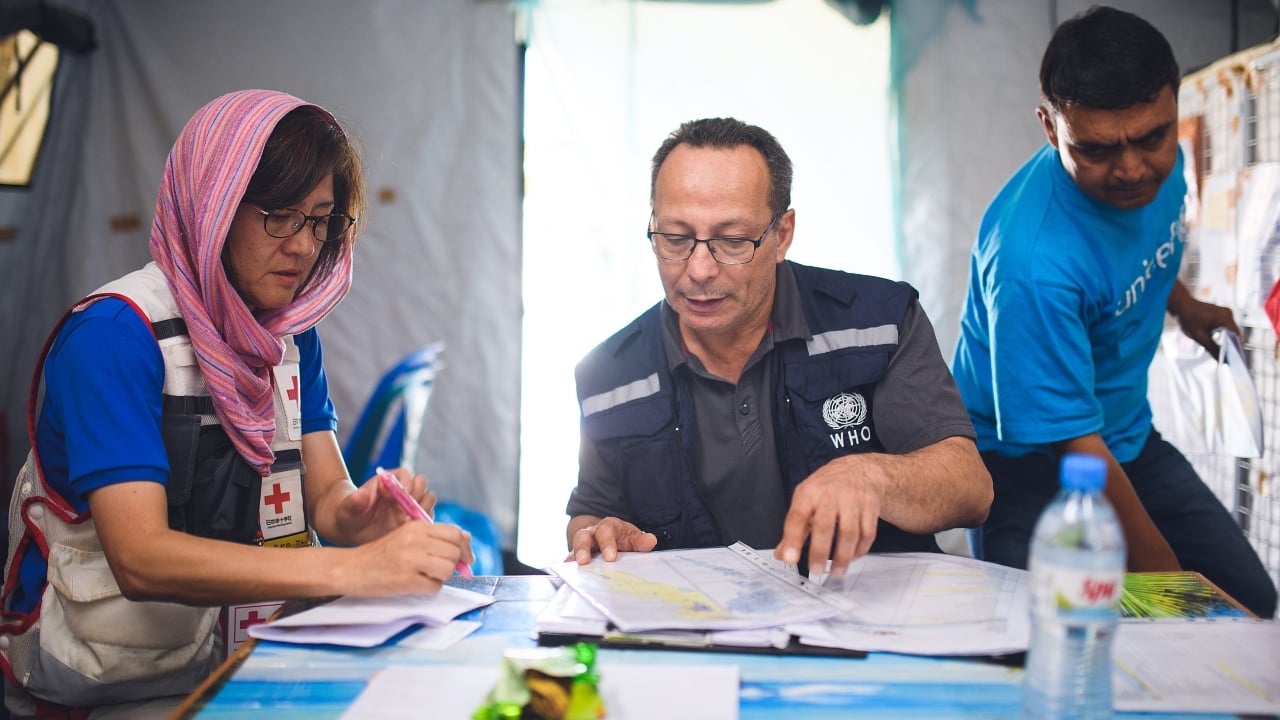

Featured
Why Public Health Is Important
Modified: January 2, 2024
Discover why public health is crucial to our communities. Explore featured articles on the importance of public health initiatives and improving overall well-being.
Introduction
Public health plays a crucial role in ensuring the well-being of individuals and communities. It encompasses a range of activities and initiatives aimed at protecting and improving the health of populations. By focusing on disease prevention, health promotion, emergency preparedness, and health equity, public health aims to create healthier and more resilient societies.
At its core, public health is about understanding the factors that influence health outcomes and taking proactive measures to address them. It involves identifying community health needs, implementing interventions, and evaluating their effectiveness. Public health professionals collaborate with various stakeholders, including government agencies, healthcare providers, nonprofit organizations, and community members, to create and implement evidence-based strategies.
Public health is an interdisciplinary field that draws on knowledge from various disciplines, such as epidemiology, biostatistics, environmental health, social sciences, and policy. This multidimensional approach allows for a comprehensive understanding of health determinants and effective interventions.
In this article, we will explore the different aspects of public health and why they are crucial for the well-being of individuals and communities. We will delve into disease prevention and control, health promotion, emergency preparedness and response, environmental health, health equity, and the importance of public health policies and systems. Additionally, we will examine the economic impact of public health initiatives.
It is essential to recognize that public health is not limited to the actions of professionals or organizations alone. Each individual has a role to play in preserving and improving public health. By understanding the importance of public health and actively participating in efforts to promote and protect it, we can collectively create healthier communities and improve the overall well-being of society.
Role of Public Health
Public health plays a critical role in safeguarding the health and well-being of individuals and communities. It encompasses a wide range of activities aimed at preventing disease, promoting health, and ensuring a prompt response to emergencies. By addressing the social, economic, and environmental determinants of health, public health efforts strive to create conditions that enable people to lead healthy lives.
One of the primary functions of public health is disease prevention and control. Public health professionals work tirelessly to identify, track, and contain communicable diseases. Through surveillance systems, they monitor the spread of diseases and implement measures to prevent outbreaks and epidemics. Vaccination campaigns, health education, and screening programs are among the strategies employed to minimize the impact of infectious diseases on populations.
Health promotion is another vital aspect of public health. It involves empowering individuals and communities to take control of their health and adopt healthy behaviors. Public health initiatives aim to educate the public about the importance of physical activity, balanced nutrition, and tobacco and alcohol cessation. By fostering healthy habits and empowering individuals with knowledge, public health contributes to the prevention of chronic diseases and the overall improvement of well-being.
Public health also plays a crucial role in emergency preparedness and response. Whether it is a natural disaster, a disease outbreak, or a public health emergency, public health professionals work hand in hand with other agencies to plan and coordinate disaster response efforts. They ensure that the necessary infrastructure, resources, and protocols are in place to effectively respond to emergencies, minimize harm, and restore communities to their pre-event state.
Another area where public health makes a significant impact is environmental health. Public health professionals assess and mitigate environmental factors that can adversely affect human health. They monitor air and water quality, investigate environmental hazards, and educate the public about measures to minimize exposure to harmful substances. By protecting the environment, public health contributes to disease prevention and improves the overall quality of life.
Furthermore, public health endeavors to address health inequalities and promote health equity. By recognizing that health outcomes are influenced by various social determinants, including income, education, and access to healthcare, public health professionals strive to eliminate health disparities. They advocate for policies and interventions that create equitable opportunities for all individuals to achieve optimal health.
Public health operates within a framework of policies and systems that support and facilitate its goals. These policies range from legislation to promote healthy behaviors to regulations that ensure the safety of food and water. Public health systems work to build infrastructure, capacity, and partnerships to deliver effective public health services and respond to emerging health threats.
Lastly, public health has a significant economic impact. Investments in public health yield substantial returns in terms of cost savings and productivity gains. By preventing diseases and promoting healthy lifestyles, public health initiatives reduce the burden on healthcare systems, enhance workforce productivity, and contribute to overall economic development.
Understanding the multifaceted role of public health is essential for creating healthier communities and improving population health outcomes. By implementing evidence-based strategies and fostering collaboration between various stakeholders, public health professionals work towards achieving the vision of a healthier and more resilient society.
Disease Prevention and Control
Disease prevention and control is a fundamental aspect of public health that focuses on reducing the incidence and burden of communicable diseases. Public health professionals employ a range of strategies to prevent the spread of infectious diseases and minimize their impact on populations.
One of the key methods used in disease prevention is surveillance. Public health agencies collect data on the occurrence and distribution of diseases, allowing them to identify patterns and trends. This information helps guide decision-making and enables the timely implementation of control measures. Surveillance systems also facilitate the early detection of outbreaks, allowing for prompt intervention and containment.
Vaccination campaigns are another essential tool in disease prevention. Immunizations protect individuals from a range of infectious diseases, preventing them from becoming infected and reducing the likelihood of onward transmission. Vaccination programs aim to achieve high coverage rates to establish herd immunity, meaning that a large portion of the population is immune, effectively safeguarding vulnerable individuals who cannot receive vaccines due to medical conditions.
Health education and promotion play a vital role in disease prevention and control. Public health initiatives focus on raising awareness about disease transmission and prevention methods. This includes educating the public about proper hand hygiene, safe food handling practices, and the importance of respiratory etiquette. Additionally, campaigns may focus on promoting behaviors such as safe sex, responsible antibiotic use, and regular health screenings.
Public health agencies also employ contact tracing to identify individuals who may have been exposed to a contagious disease. Contact tracing involves identifying and monitoring individuals who have had close contact with an infected person. By quickly identifying and isolating those at risk of transmitting the disease, public health measures can help prevent further spread. This approach has been particularly vital in controlling outbreaks of diseases such as tuberculosis and sexually transmitted infections.
In addition to these primary prevention strategies, public health focuses on outbreak management and control. This involves rapidly responding to an outbreak by identifying cases, implementing infection control measures, and providing appropriate treatment. Public health agencies work closely with healthcare providers, laboratories, and other partners to ensure a coordinated and effective response to outbreaks.
Overall, disease prevention and control are essential components of public health efforts. By implementing comprehensive surveillance systems, promoting vaccination, conducting health education campaigns, and employing contact tracing and outbreak management strategies, public health professionals work to prevent the spread of communicable diseases and protect the health of populations.
Health Promotion
Health promotion is a crucial aspect of public health that focuses on empowering individuals and communities to take control of their health and make choices that lead to improved well-being. Through various initiatives and interventions, health promotion aims to create environments that support healthy behaviors and foster a culture of wellness.
One of the main objectives of health promotion is to educate the public about the importance of adopting healthy behaviors. Public health campaigns provide information and resources on topics such as physical activity, nutrition, smoking cessation, and mental health. By increasing awareness and knowledge, health promotion empowers individuals to make informed decisions about their lifestyle choices.
Physical activity is a key area of focus in health promotion. Regular exercise has numerous benefits, including reducing the risk of chronic diseases such as heart disease, diabetes, and certain types of cancer. Health promotion initiatives encourage individuals of all ages to engage in physical activity that suits their abilities and preferences. This can include activities such as walking, cycling, swimming, or participating in organized sports.
Nutrition is another critical component of health promotion. Public health campaigns emphasize the importance of a balanced diet that includes a variety of fruits, vegetables, whole grains, lean proteins, and healthy fats. They educate individuals about portion sizes, the benefits of reducing sugar and sodium intake, and the importance of staying hydrated. By promoting healthy eating habits, health promotion contributes to the prevention of diet-related diseases such as obesity and cardiovascular conditions.
Health promotion efforts also address factors that contribute to mental well-being. Mental health is an integral part of overall health, and promoting positive mental health is essential. Public health campaigns raise awareness about mental health issues, reduce stigma, and highlight the importance of seeking help and support. They also aim to create supportive environments in schools, workplaces, and communities that prioritize mental well-being.
Tobacco and alcohol cessation programs are another important aspect of health promotion. Public health initiatives focus on promoting tobacco-free environments, educating about the dangers of smoking and secondhand smoke, and providing resources for smoking cessation. Similarly, efforts are made to raise awareness about responsible alcohol consumption and support individuals in making healthy choices regarding alcohol use.
Health promotion recognizes that creating healthy communities requires collaboration and the involvement of multiple sectors. Public health professionals work with schools, workplaces, local governments, and community organizations to create environments that facilitate healthy choices. This can include initiatives such as tobacco-free policies, promoting healthy food options in schools, and ensuring access to safe recreational spaces.
By promoting healthy behaviors and creating supportive environments, health promotion contributes to the prevention of chronic diseases, improves overall quality of life, and reduces healthcare costs. It emphasizes the importance of taking a proactive approach to health and recognizes that individual choices are influenced by the wider social, economic, and environmental determinants of health.
Emergency Preparedness and Response
Emergency preparedness and response is a critical component of public health that focuses on the ability to effectively handle and mitigate the impact of emergencies, disasters, and public health crises. Public health agencies work tirelessly to ensure that communities are prepared to respond to various events, ranging from natural disasters like hurricanes and earthquakes to disease outbreaks and pandemics.
One of the key aspects of emergency preparedness is planning. Public health agencies collaborate with other stakeholders to develop comprehensive emergency response plans that outline roles, responsibilities, and protocols. These plans cover a wide range of scenarios and address various aspects such as communication strategies, resource mobilization, evacuation procedures, and coordination with other agencies.
Public health agencies also play a crucial role in early detection and surveillance of emergencies. Through robust surveillance systems, they monitor and analyze data to detect potential threats or outbreaks early on. This enables swift and targeted action to prevent or minimize the impact of emergencies. Surveillance systems are particularly vital in detecting and responding to emerging infectious diseases, allowing for early containment measures.
In the event of an emergency, public health agencies set up emergency response operations centers. These centers serve as the command and control hub for coordinating and managing response efforts. They facilitate communication and coordination among various stakeholders, including health professionals, emergency responders, government agencies, and community organizations.
Emergency response teams are deployed to affected areas to provide medical assistance, establish temporary healthcare facilities, and ensure the availability of essential services. Public health professionals work on the ground to assess the needs of the affected population, provide medical care, administer vaccinations, distribute supplies, and implement disease surveillance and control measures.
Another critical aspect of emergency preparedness and response is public communication. Public health agencies play a vital role in disseminating timely and accurate information to the public. This includes sharing updates on the situation, providing guidance on protective measures, and addressing concerns and misconceptions. Effective communication is essential to ensure that the public remains informed, engaged, and cooperative during times of crisis.
Post-emergency recovery is another key aspect of public health’s role in emergency response. Public health agencies work with communities to assess and address the long-term health needs and psychosocial impacts after an emergency. This may include providing mental health support, monitoring for potential outbreaks, and working towards restoring healthcare services and infrastructure.
By actively engaging in emergency preparedness, response, and recovery, public health agencies and professionals contribute to the overall resilience and well-being of communities. Their efforts help protect lives, minimize the adverse health effects of emergencies, and ensure a prompt return to normalcy after a crisis.
Environmental Health
Environmental health is a crucial aspect of public health that focuses on understanding and mitigating the impact of environmental factors on human health. It encompasses a wide range of issues, including air and water quality, food safety, waste management, and occupational health. By identifying and addressing environmental hazards, public health professionals work to create healthier and safer communities.
Air pollution is one of the primary concerns in environmental health. Public health agencies monitor air quality, assess the levels of pollutants, and work towards reducing exposure to harmful substances. By implementing regulations to control emissions from industrial sources, promoting clean energy alternatives, and raising awareness about the health effects of poor air quality, public health initiatives aim to improve respiratory health and reduce the burden of diseases such as asthma and cardiovascular conditions.
Water quality is another critical component of environmental health. Public health agencies work to ensure that drinking water sources are safe and free from contaminants. They establish standards for water quality, monitor water supplies, and educate the public about water treatment and purification methods. By safeguarding the quality of water sources, public health promotes the prevention of waterborne diseases and protects the health of communities.
Food safety is a vital aspect of environmental health. Public health agencies enforce regulations and standards to ensure that food is safely produced, processed, and prepared. Regular inspections of food establishments, proper handling and storage practices, and the prevention of foodborne illnesses are key priorities. By promoting safe food practices and providing education about proper food handling and storage, public health protects individuals from foodborne diseases.
Waste management is essential for maintaining a healthy environment. Public health agencies work to establish regulations and systems for proper waste disposal and recycling. This includes managing hazardous waste, promoting responsible waste reduction and recycling practices, and addressing issues such as illegal dumping. By ensuring proper waste management, public health helps prevent environmental contamination and reduces the risk of exposure to harmful substances.
Occupational health is another crucial area within environmental health. Public health agencies work to protect workers from occupational hazards and ensure safe working conditions. This involves enforcing workplace safety regulations, conducting inspections, and promoting the use of personal protective equipment. By addressing occupational health hazards, public health contributes to the prevention of work-related injuries, illnesses, and long-term health effects.
Environmental justice is an important component of environmental health. Public health agencies strive to address health disparities and ensure that all individuals have access to a safe and healthy environment. This includes advocating for equitable distribution of resources, addressing environmental inequalities in marginalized communities, and involving community members in decision-making processes. Environmental justice efforts aim to eliminate health disparities and promote social equity in access to a healthy environment.
By focusing on environmental health, public health professionals work to prevent diseases and improve overall well-being. By addressing air and water quality, food safety, waste management, occupational health, and environmental justice, they aim to create environments that support optimal health for all individuals and promote the sustainable use of natural resources.
Health Equity and Social Justice
Health equity and social justice are essential principles within public health that aim to address and reduce health disparities among different populations. They recognize that health outcomes are shaped by social, economic, and environmental factors, and advocate for fair and equitable access to resources and opportunities that promote health and well-being.
Health equity focuses on ensuring that everyone has a fair opportunity to achieve their fullest health potential, regardless of their socioeconomic status, race, ethnicity, gender, or other social determinants of health. It recognizes that certain groups face systematic barriers to accessing healthcare, education, employment, and other social determinants that influence health. Public health professionals work to identify and address these inequities by advocating for policies and interventions that promote equitable access to healthcare, quality education, affordable housing, and employment opportunities.
Social justice is closely intertwined with health equity and aims to create a more equal and just society by addressing the root causes of inequality. It acknowledges that health disparities are not random or accidental, but rather the result of systemic and structural injustices. Social justice interventions focus on dismantling discriminatory policies and practices, promoting human rights, and challenging power imbalances that perpetuate health disparities.
Public health efforts in health equity and social justice involve engaging communities, advocating for policy change, and addressing the social determinants of health. Community engagement is crucial in identifying the unique needs and concerns of specific populations, and empowering individuals to participate in decisions that affect their health. By working together with community members, public health professionals can develop more effective and contextually relevant interventions that address the root causes of health disparities.
Advocacy plays a significant role in promoting health equity and social justice. Public health professionals advocate for policies that address social determinants of health, such as affordable housing, income inequality, food security, and access to education. They also work towards reducing barriers to healthcare, including improving access to quality primary care, mental health services, and preventive care. Effective advocacy involves collaborating with policymakers, community organizations, and other stakeholders to push for changes at local, regional, and national levels.
Addressing health equity and social justice requires an intersectional approach that recognizes the interconnected nature of various forms of oppression and discrimination. Public health professionals strive to address the unique challenges faced by marginalized populations, including racial and ethnic minorities, LGBTQ+ communities, individuals with disabilities, and those experiencing poverty. This involves challenging implicit biases in healthcare systems, advocating for inclusive practices, and promoting culturally sensitive and responsive care.
By prioritizing health equity and social justice, public health professionals aim to create a more just and equitable society where individuals can thrive regardless of their background or circumstances. By addressing the social determinants of health, advocating for policy change, and engaging communities, public health plays a critical role in working towards a more equitable and inclusive future.
Importance of Public Health Policies and Systems
Public health policies and systems are vital for promoting and protecting the health of populations. They provide a framework for how public health initiatives are planned, implemented, and evaluated. These policies and systems play a significant role in disease prevention, health promotion, emergency preparedness, and overall population health management.
One of the key aspects of public health policies and systems is their focus on evidence-based decision making. Policies are developed and implemented based on scientific research, best practices, and data-driven analysis. This ensures that public health interventions and strategies are effective in addressing health challenges and achieving desired outcomes.
Public health policies help create an environment that supports healthy behaviors and reduces risk factors for diseases. They encompass a wide range of measures, including regulations, guidelines, and initiatives that promote health and well-being. Examples of public health policies include smoking bans in public places, mandatory vaccinations, food labeling requirements, and restrictions on the marketing of unhealthy foods and beverages to children.
Public health systems enable the coordination and delivery of essential public health services. They encompass a network of organizations, agencies, and healthcare providers collaborating to achieve common public health goals. These systems are responsible for disease surveillance, healthcare planning, emergency response coordination, and health promotion efforts.
A robust public health system ensures that communities are prepared to mitigate and respond to emerging health threats and emergencies. It coordinates efforts between different agencies and stakeholders to effectively manage outbreaks, natural disasters, and other public health crises. By establishing protocols, training personnel, and ensuring the availability of necessary resources, public health systems play a vital role in protecting communities.
An important aspect of public health policies and systems is their focus on health equity. They aim to reduce health disparities and ensure that individuals and communities have equal opportunities to achieve optimal health. Public health policies and systems strive to address social determinants of health, such as income, education, and access to healthcare, by advocating for policies that promote health equity and creating targeted interventions for marginalized and underserved populations.
In addition, public health policies and systems play a significant role in resource allocation and healthcare planning. They assist in setting priorities, identifying public health needs, and allocating resources effectively and efficiently. These policies and systems guide the distribution of funding, workforce development, and infrastructure improvements to strengthen the delivery of public health services.
Furthermore, public health policies and systems drive collaborations among different sectors and stakeholders. They involve partnerships with healthcare providers, government agencies, community organizations, and academic institutions. These collaborations facilitate the exchange of knowledge, expertise, and resources, leading to innovative solutions and the overall improvement of public health outcomes.
Overall, public health policies and systems are essential for improving population health, mitigating health risks, and advancing health equity. They provide the framework necessary for the development and implementation of effective public health interventions, ensuring the well-being of individuals and communities.
Economic Impact of Public Health
Public health initiatives have a significant and far-reaching impact on the economy. By promoting disease prevention, improving population health, and reducing healthcare costs, public health plays a crucial role in sustaining economic growth and productivity.
One key economic impact of public health is cost savings in the healthcare sector. By focusing on disease prevention and health promotion, public health initiatives reduce the burden of chronic diseases and infectious diseases. Prevention measures, such as vaccinations, screening programs, and health education campaigns, help individuals avoid costly medical treatments and hospitalizations. By reducing the demand for healthcare services, public health initiatives alleviate the strain on healthcare systems and lower healthcare costs for individuals, employers, and governments.
Public health also contributes to economic growth by improving workforce productivity. By promoting healthy behaviors and preventing diseases, public health initiatives reduce absenteeism and increase employee productivity. Healthy individuals are more likely to be engaged in their work, experience fewer sick days, and have better cognitive function. Additionally, public health efforts that focus on occupational safety and well-being create safer work environments, reducing workplace accidents and injuries that can result in productivity losses.
Public health also plays a pivotal role in attracting investments and promoting economic development. Companies and investors consider the health and well-being of a community when deciding on new business ventures or locations. Communities with strong public health infrastructure and initiatives are more likely to attract businesses and investments, contributing to job creation and economic growth. This, in turn, leads to increased tax revenue, improved public services, and a higher quality of life for residents.
Furthermore, public health emergencies and outbreaks can have severe economic consequences. During a public health crisis, such as a pandemic or natural disaster, the economic impact can be significant. Public health interventions, such as quarantine measures and travel restrictions, can disrupt supply chains, impact tourism, and lead to reduced consumer spending. By effectively managing and mitigating the impact of such crises, public health agencies help safeguard the economy and support business continuity.
Investments in public health have a high return on investment. Studies have shown that every dollar invested in public health initiatives can yield a significant economic return. This return is a result of the cost savings in healthcare, increased productivity, and improved quality of life. By prioritizing public health funding and investments, governments and organizations can achieve substantial long-term economic benefits.
In summary, public health initiatives have a profound economic impact. By promoting disease prevention, improving population health, enhancing workforce productivity, attracting investments, and mitigating the economic impact of public health crises, public health plays a crucial role in sustaining economic growth, reducing healthcare costs, and creating a healthier and more prosperous society.
Conclusion
Public health is of paramount importance in ensuring the well-being and vitality of individuals and communities. Its multifaceted role encompasses disease prevention and control, health promotion, emergency preparedness and response, environmental health, health equity, and the development of effective policies and systems. By addressing the social, economic, and environmental factors that impact health outcomes, public health professionals work towards creating healthier and more resilient societies.
Disease prevention and control form the foundation of public health efforts, aiming to track and contain communicable diseases, promote immunizations, and implement health education campaigns. Health promotion initiatives empower individuals and communities to adopt healthy behaviors, promoting physical activity, balanced nutrition, mental health support, and responsible lifestyle choices.
Emergency preparedness and response play a critical role in ensuring communities are prepared for and able to respond effectively to emergencies, natural disasters, and public health crises. By establishing comprehensive plans, surveillance systems, and response operations, public health agencies contribute to minimizing harm and rapidly restoring normality.
Environmental health initiatives address factors such as air and water quality, food safety, waste management, and occupational health to safeguard human health. Through promoting equitable access to resources and opportunities, public health efforts work towards health equity and social justice, recognizing and addressing systemic barriers that contribute to health disparities.
Public health policies and systems provide the structure and framework necessary for effective public health interventions. They guide decision making, promote evidence-based strategies, and support collaborative efforts across various sectors and stakeholders. The economic impact of public health initiatives is substantial, reducing healthcare costs, improving workforce productivity, and attracting investments.
In conclusion, public health is a crucial field that encompasses a wide range of disciplines and activities aimed at protecting and improving the health of populations. By addressing the social, economic, and environmental determinants of health, public health professionals work towards creating healthier communities and promoting health equity. The importance of public health cannot be overstated, as it plays a vital role in safeguarding the well-being of individuals and societies as a whole. By prioritizing public health initiatives, investing in effective strategies, and advocating for health equity, we can build healthier and more resilient communities and improve the overall well-being of society.









